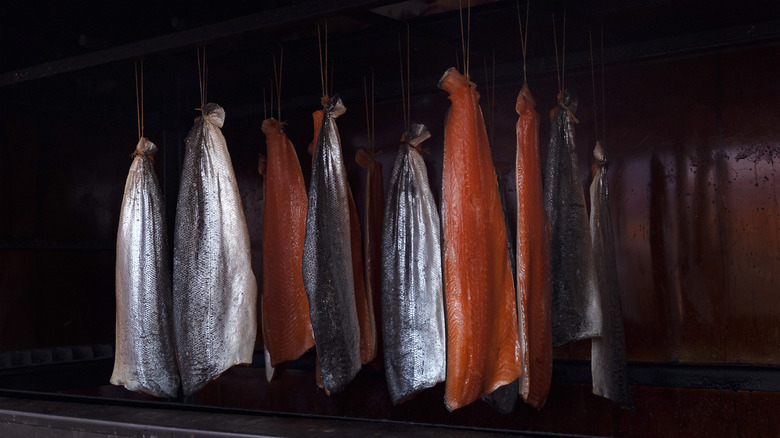Lox Vs Smoked Salmon: What's The Difference?
A good bagel needs to be fresh, with a crisp crust and a chewy interior, but that alone won't cut it. You've got to pile on the classic toppings: New York deli cream cheese, some tomatoes, capers, and onions if you're feeling fancy, and of course, a few slices of lox. That's a common order at any bagel shop, and yet, it's technically incorrect. In reality, the popular pink topping we're all calling lox is, in fact, almost never lox.
What you'll find on most bagel sandwiches is actually smoked salmon. Many people use the terms "smoked salmon" and "lox" interchangeably, but they're not actually the same. They are closely related — both products typically begin by curing salmon in salt — but smoked salmon involves a few extra steps. Each product also has multiple variations, some of which are common, and others of which you may never have heard of. In the end, lox and smoked salmon have very different flavor profiles, textures, and uses.
Lox is not smoked
Lox refers to cured salmon, that is, salmon preserved by salt. The curing process can be accomplished in a few different ways. Sometimes, lox is cured in plain salt, or a combination of salt and sugar. Other times, it is cured in a salt brine, which sometimes includes sugar as well. This process can take a few days, or up to a few months, after which the fish is rinsed off before eating. The most important difference between smoked salmon and lox is that lox is not actually cooked, and its flavor is dominated by salt.
The word "lox" is thought to derive from the Yiddish word "laks," referring to salmon. However, the dish actually originated in Scandinavian cuisine before spreading to Eastern Europe's Jewish population. Nordic nations continue to make a version of lox called gravlax. Unlike other types of lox, which typically use only the salmon belly, gravlax is made from a whole salmon fillet and is cured with a variety of herbs and spices.
When you think of lox, you probably mean smoked salmon
Smoked salmon begins the same way as lox, with a salt cure. However, the curing time is shorter than that of lox — typically only a day — which makes smoked salmon less salty. The other flavor factor separating lox and smoked salmon is, of course, the smoke. After brining, smoked salmon goes into a smoker, where it picks up the flavor of whatever wood is being used. Alder wood is a particularly common choice for smoking salmon, as it has a mild flavor that won't overpower the fish. Hickory and mesquite may be used to impart a stronger smoky flavor. Smoked salmon looks a lot like poached salmon, except for the unique variety used on bagels.
The popular bagel topping most people think of as lox is actually a variety of smoked salmon called Nova (short for Gaspé Nova), which originated in Nova Scotia. Nova is cold-smoked, meaning that it is smoked at a very low temperature (not more than 85 degrees Fahrenheit). Since this is barely above room temperature, Nova doesn't actually cook, it just takes on the flavor of the smoke. In the end, it's still raw, just like lox. While Nova technically counts as smoked salmon, it is really more of a bridge between smoked salmon and lox. It's less salty than lox, but not as smoky as other types of smoked salmon. It's the best of both worlds, and it's no surprise that it's come to dominate the bagel world.


